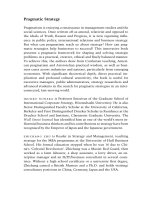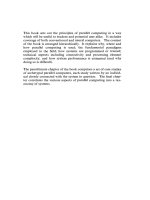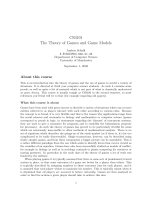Microeconomic theory basic principles and extensionsrepost
Bạn đang xem bản rút gọn của tài liệu. Xem và tải ngay bản đầy đủ của tài liệu tại đây (9.72 MB, 782 trang )
This page intentionally left blank
MICROECONOMIC THEORY
This is an electronic version of the print textbook. Due to electronic rights restrictions,
some third party content may be suppressed. Editorial review has deemed that any suppressed
content does not materially affect the overall learning experience. The publisher reserves the right
to remove content from this title at any time if subsequent rights restrictions require it. For
valuable information on pricing, previous editions, changes to current editions, and alternate
formats, please visit www.cengage.com/highered to search by ISBN#, author, title, or keyword for
materials in your areas of interest.
Microeconomic Theory
Basic Principles and Extensions
ELEVENTH EDITION
WALTER NICHOLSON
Amherst College
CHRISTOPHER SNYDER
Dartmouth College
Australia • Brazil • Japan • Korea • Mexico • Singapore • Spain • United Kingdom • United States
Microeconomic Theory: Basic Principles
and Extensions, Eleventh Edition
Walter Nicholson, Christopher Snyder
VP/Editorial Director: Jack W. Calhoun
Publisher: Joe Sabatino
Sr. Acquisitions Editor: Steve Scoble
Sr. Developmental Editor: Susanna C. Smart
Marketing Manager: Nathan Anderson
Sr. Content Project Manager: Cliff Kallemeyn
Media Editor: Sharon Morgan
Sr. Frontlist Buyer: Kevin Kluck
Sr. Marketing Communications Manager:
Sarah Greber
ª 2012, 2008 South-Western, Cengage Learning
ALL RIGHTS RESERVED. No part of this work covered by the copyright
herein may be reproduced, transmitted, stored, or used in any form or
by any means graphic, electronic, or mechanical, including but not
limited to photocopying, recording, scanning, digitizing, taping, web
distribution, information networks, or information storage and retrieval
systems, except as permitted under Section 107 or 108 of the 1976
United States Copyright Act, without the prior written permission of
the publisher.
For product information and technology assistance, contact us at
Cengage Learning Customer & Sales Support, 1-800-354-9706
For permission to use material from this text or product, submit all
requests online at www.cengage.com/permissions
Further permissions questions can be emailed to
Sr. Rights Specialist: Deanna Ettinger
Production Service: Cenveo Publisher Services
Sr. Art Director: Michelle Kunkler
Internal Designer: Juli Cook/Plan-It Publishing
Cover Designer: Red Hangar Design LLC
Cover Image: ª Jason Reed/Getty Images
Library of Congress Control Number: 2011928483
ISBN-13: 978-111-1-52553-8
ISBN-10: 1-111-52553-6
South-Western
5191 Natorp Boulevard
Mason, OH 45040
USA
Cengage Learning products are represented in Canada by Nelson
Education, Ltd.
For your course and learning solutions, visit www.cengage.com
Purchase any of our products at your local college store or at our
preferred online store www.cengagebrain.com
All graphs and figures owned by Cengage Learning. ª 2010 Cengage
Learning.
Printed in the United States of America
1 2 3 4 5 6 7 15 14 13 12 11
To Beth, Sarah, David, Sophia, Abby, Nate, and Christopher
To Maura
This page intentionally left blank
About the authors
Walter Nicholson is the Ward H. Patton Professor of Economics at Amherst College.
He received a B.A. in mathematics from Williams College and a Ph.D. in economics
from the Massachusetts Institute of Technology (MIT). Professor Nicholson’s primary
research interests are in the econometric analyses of labor market problems, including
welfare, unemployment, and the impact of international trade. For many years, he has
been Senior Fellow at Mathematica, Inc. and has served as an advisor to the U.S. and
Canadian governments. He and his wife, Susan, live in Naples, Florida, and Amherst,
Massachusetts.
Christopher M. Snyder is a Professor of Economics at Dartmouth College. He received
his B.A. in economics and mathematics from Fordham University and his Ph.D. in economics from MIT. He is Research Associate in the National Bureau of Economic
Research, a member of the Industrial Organization Society board, and Associate Editor of
the International Journal of Industrial Organization and Review of Industrial Organization. His research covers various theoretical and empirical topics in industrial organization, contract theory, and law and economics.
Professor Snyder and his wife Maura Doyle (who also teaches economics at Dartmouth) live within walking distance of campus in Hanover, New Hampshire, with their
three school-aged daughters.
Professors Nicholson and Snyder are also the authors of Intermediate Microeconomics
and Its Application (Cengage Learning, 2010).
vii
This page intentionally left blank
Brief Contents
Preface
PART
ONE
xix
Introduction
CHAPTER 1
CHAPTER 2
PART
TWO
CHAPTER 4
CHAPTER 5
CHAPTER 6
PART
CHAPTER 8
PART
CHAPTER 10
CHAPTER 11
FIVE
CHAPTER 13
SIX
CHAPTER 15
PART
CHAPTER 17
PART
Production Functions 303
Cost Functions 333
Profit Maximization 371
The Partial Equilibrium Competitive Model
General Equilibrium and Welfare 457
Monopoly 501
Imperfect Competition
Pricing in Input Markets
CHAPTER 16
EIGHT
301
409
Market Power 499
CHAPTER 14
SEVEN
Uncertainty 209
Game Theory 251
Competitive Markets 407
CHAPTER 12
PART
Preferences and Utility 89
Utility Maximization and Choice 117
Income and Substitution Effects 145
Demand Relationships among Goods 187
Production and Supply
CHAPTER 9
PART
21
Uncertainty and Strategy 207
CHAPTER 7
FOUR
Economic Models 3
Mathematics for Microeconomics
Choice and Demand 87
CHAPTER 3
THREE
1
CHAPTER 19
579
Labor Markets 581
Capital and Time 607
Market Failure
CHAPTER 18
531
639
Asymmetric Information 641
Externalities and Public Goods
685
Brief Answers to Queries 717
Solutions to Odd-Numbered Problems 727
Glossary of Frequently Used Terms 739
Index 747
ix
This page intentionally left blank
Contents
Preface ................................................................................................................................................ xix
PART
ONE
Introduction
CHAPTER
1
Economic Models .................................................................................................................... 3
Theoretical Models 3
Verification of Economic Models 4
General Features of Economic Models 5
Development of the Economic Theory of Value 9
Modern Developments 17
Summary 18
Suggestions for Further Reading 19
CHAPTER
2
Mathematics for Microeconomics...................................................................................... 21
Maximization of a Function of One Variable 21
Functions of Several Variables 26
Maximization of Functions of Several Variables 33
The Envelope Theorem 35
Constrained Maximization 39
Envelope Theorem in Constrained Maximization Problems 45
Inequality Constraints 46
Second-Order Conditions and Curvature 48
Homogeneous Functions 55
Integration 58
Dynamic Optimization 63
Mathematical Statistics 67
Summary 76
Problems 77
Suggestions for Further Reading 82
Extensions: Second-Order Conditions and Matrix Algebra 83
PART
TWO
Choice and Demand
CHAPTER
3
Preferences and Utility......................................................................................................... 89
Axioms of Rational Choice 89
xi
xii
Contents
Utility 90
Trades and Substitution 92
The Mathematics of Indifference Curves 99
Utility Functions for Specific Preferences 102
The Many-Good Case 106
Summary 106
Problems 107
Suggestions for Further Reading 110
Extensions: Special Preferences 112
CHAPTER
4
Utility Maximization and Choice....................................................................................... 117
An Initial Survey 118
The Two-Good Case: A Graphical Analysis 119
The n-Good Case 122
Indirect Utility Function 128
The Lump Sum Principle 129
Expenditure Minimization 131
Properties of Expenditure Functions 134
Summary 136
Problems 136
Suggestions for Further Reading 140
Extensions: Budget Shares 141
CHAPTER
5
Income and Substitution Effects ....................................................................................... 145
Demand Functions 145
Changes in Income 147
Changes in a Good’s Price 149
The Individual’s Demand Curve 152
Compensated (Hicksian) Demand Curves and Functions 155
A Mathematical Development of Response to Price Changes 160
Demand Elasticities 163
Consumer Surplus 169
Revealed Preference and the Substitution Effect 174
Summary 176
Problems 177
Suggestions for Further Reading 180
Extensions: Demand Concepts and the Evaluation of Price Indices 181
CHAPTER
6
Demand Relationships among Goods............................................................................... 187
The Two-Good Case 187
Substitutes and Complements 189
Net (Hicksian) Substitutes and Complements 191
Contents
xiii
Substitutability with Many Goods 193
Composite Commodities 193
Home Production, Attributes of Goods, and Implicit Prices 197
Summary 200
Problems 200
Suggestions for Further Reading 203
Extensions: Simplifying Demand and Two-Stage Budgeting 204
PART
THREE
Uncertainty and Strategy
CHAPTER
7
Uncertainty ........................................................................................................................... 209
Mathematical Statistics 209
Fair Gambles and the Expected Utility Hypothesis 210
Expected Utility 211
The von Neumann–Morgenstern Theorem 212
Risk Aversion 214
Measuring Risk Aversion 217
Methods for Reducing Uncertainty and Risk 222
Insurance 222
Diversification 223
Flexibility 224
Information 231
The State-Preference Approach to Choice Under Uncertainty 232
Asymmetry of Information 238
Summary 238
Problems 239
Suggestions for Further Reading 242
Extensions: The Portfolio Problem 244
CHAPTER
8
Game Theory ........................................................................................................................ 251
Basic Concepts 251
Prisoners’ Dilemma 252
Nash Equilibrium 254
Mixed Strategies 260
Existence of Equilibrium 265
Continuum of Actions 265
Sequential Games 268
Repeated Games 274
Incomplete Information 277
Simultaneous Bayesian Games 278
Signaling Games 282
Experimental Games 288
xiv
Contents
Evolutionary Games and Learning 290
Summary 290
Problems 291
Suggestions for Further Reading 295
Extensions: Existence of Nash Equilibrium
PART
FOUR
296
Production and Supply
CHAPTER
9
Production Functions .......................................................................................................... 303
Marginal Productivity 303
Isoquant Maps and the Rate of Technical Substitution 306
Returns to Scale 310
The Elasticity of Substitution 313
Four Simple Production Functions 316
Technical Progress 320
Summary 324
Problems 325
Suggestions for Further Reading 328
Extensions: Many-Input Production Functions 329
CHAPTER
10
Cost Functions...................................................................................................................... 333
Definitions of Costs 333
Cost-Minimizing Input Choices 336
Cost Functions 341
Cost Functions and Shifts in Cost Curves 345
Shephard’s Lemma and the Elasticity of Substitution 355
Short-Run, Long-Run Distinction 355
Summary 362
Problems 363
Suggestions for Further Reading 366
Extensions: The Translog Cost Function 367
CHAPTER
11
Profit Maximization ............................................................................................................. 371
The Nature and Behavior of Firms 371
Profit Maximization 373
Marginal Revenue 375
Short-Run Supply by a Price-Taking Firm 380
Profit Functions 383
Profit Maximization and Input Demand 389
Summary 395
Problems 396
Suggestions for Further Reading 400
Extensions: Boundaries of the Firm 401
Contents
PART
FIVE
xv
Competitive Markets
CHAPTER
12
The Partial Equilibrium Competitive Model .................................................................... 409
Market Demand 409
Timing of the Supply Response 413
Pricing in the Very Short Run 413
Short-Run Price Determination 415
Shifts in Supply and Demand Curves: A Graphical Analysis 419
Mathematical Model of Market Equilibrium 422
Long-Run Analysis 425
Long-Run Equilibrium: Constant Cost Case 426
Shape of the Long-Run Supply Curve 428
Long-Run Elasticity of Supply 431
Comparative Statics Analysis of Long-Run Equilibrium 431
Producer Surplus in the Long Run 435
Economic Efficiency and Welfare Analysis 438
Price Controls and Shortages 441
Tax Incidence Analysis 442
Summary 447
Problems 447
Suggestions for Further Reading 451
Extensions: Demand Aggregation and Estimation 453
CHAPTER
13
General Equilibrium and Welfare ..................................................................................... 457
Perfectly Competitive Price System 457
A Graphical Model of General Equilibrium with Two Goods 458
Comparative Statics Analysis 467
General Equilibrium Modeling and Factor Prices 469
A Mathematical Model of Exchange 471
A Mathematical Model of Production and Exchange 482
Computable General Equilibrium Models 485
Summary 489
Problems 490
Suggestions for Further Reading 494
Extensions: Computable General Equilibrium Models 495
PART
SIX
Market Power
CHAPTER
14
Monopoly .............................................................................................................................. 501
Barriers to Entry 501
xvi
Contents
Profit Maximization and Output Choice 503
Monopoly and Resource Allocation 507
Monopoly, Product Quality, and Durability 510
Price Discrimination 513
Second-Degree Price Discrimination through Price Schedules
Regulation of Monopoly 519
Dynamic Views of Monopoly 523
Summary 523
Problems 524
Suggestions for Further Reading 527
Extensions: Optimal Linear Two-Part Tariffs 528
CHAPTER
517
15
Imperfect Competition ........................................................................................................ 531
Short-Run Decisions: Pricing and Output 531
Bertrand Model 533
Cournot Model 534
Capacity Constraints 540
Product Differentiation 541
Tacit Collusion 547
Longer-Run Decisions: Investment, Entry, and Exit 551
Strategic Entry Deterrence 557
Signaling 559
How Many Firms Enter? 562
Innovation 566
Summary 568
Problems 569
Suggestions for Further Reading 572
Extensions: Strategic Substitutes and Complements 573
PART
SEVEN
Pricing in Input Markets
CHAPTER
16
Labor Markets ...................................................................................................................... 581
Allocation of Time 581
A Mathematical Analysis of Labor Supply 584
Market Supply Curve for Labor 588
Labor Market Equilibrium 589
Wage Variation 591
Monopsony in the Labor Market 595
Labor Unions 598
Summary 601
Problems 601
Suggestions for Further Reading 605
Contents
CHAPTER
xvii
17
Capital and Time ................................................................................................................. 607
Capital and the Rate of Return 607
Determining the Rate of Return 609
The Firm’s Demand for Capital 616
Present Discounted Value Approach to Investment Decisions 618
Natural Resource Pricing 623
Summary 626
Problems 626
Suggestions for Further Reading 630
APPENDIX
The Mathematics of Compound Interest .......................................................................... 631
Present Discounted Value 631
Continuous Time 633
PART
EIGHT
Market Failure
CHAPTER
18
Asymmetric Information ..................................................................................................... 641
Complex Contracts as a Response to Asymmetric Information 641
Principal-Agent Model 642
Hidden Actions 645
Owner-Manager Relationship 646
Moral Hazard in Insurance 650
Hidden Types 655
Nonlinear Pricing 656
Adverse Selection in Insurance 663
Market Signaling 670
Auctions 672
Summary 676
Problems 676
Suggestions for Further Reading 679
Extensions: Nonlinear Pricing with a Continuum of Types 680
CHAPTER
19
Externalities and Public Goods......................................................................................... 685
Defining Externalities 685
Externalities and Allocative Inefficiency 687
Solutions to the Externality Problem 691
Attributes of Public Goods 694
Public Goods and Resource Allocation 696
Lindahl Pricing of Public Goods 700
Voting and Resource Allocation 703
A Simple Political Model 705
xviii
Contents
Voting Mechanisms 708
Summary 710
Problems 710
Suggestions for Further Reading 713
Extensions: Pollution Abatement 714
Brief Answers to Queries...............................................................................................................717
Solutions to Odd-Numbered Problems .......................................................................................727
Glossary of Frequently Used Terms ............................................................................................. 739
Index ................................................................................................................................................... 747
Preface
The 11th edition of Microeconomic Theory: Basic Principles and Extensions continues
a successful collaboration between the authors starting with the 10th edition. This edition
represents a significant effort to continue refining and modernizing our treatment of
microeconomics. Despite the significant changes appearing in virtually every chapter, the
text retains all of the elements that have made it successful for so many editions. The basic approach is to focus on building intuition about economic models while providing
students with the mathematical tools needed to go further in their studies. The text also
seeks to facilitate that linkage by providing many numerical examples, advanced problems, and extended discussions of empirical implementation—all of which are intended
to show students how microeconomic theory is used today. New developments continue
to keep the field exciting, and we hope this edition manages to capture that excitement.
New to the Eleventh Edition
We took a fresh look at every chapter to make sure that they continue to provide clear
and up-to-date coverage of all of the topics examined. The major revisions include the
following.
•
•
•
•
•
•
•
•
•
•
Many of the topics in our introductory chapter on mathematics have been revised to
conform more closely to methods usually encountered in the recent economics literature.
The chapters on uncertainty and game theory have been broken out into their own
separate part. This shrinks the part of the book on choice and demand to a more
manageable size and emphasizes the unique nature of the strategy and uncertainty
topics.
The chapter on uncertainty (Chapter 7) has been extensively revised. The sections on
real options and the value of information have been expanded. Applications to financial economics and the portfolio problem have been streamlined and collected in the
Extensions.
The treatment of game theory (Chapter 8) has been substantially streamlined, providing the same level of rigor in a third less space.
A modern treatment of the literature on firms’ boundaries and objectives (The
Theory of the Firm) has been added to the body of Chapter 9 and expanded on further in the Extensions.
Our general equilibrium chapter (Chapter 13) has been thoroughly revised. Most
notably we now use this chapter to provide students with an elementary introduction
to vector notation.
We have added a number of new topics to our discussion of labor markets focusing
mainly on issues related to human capital and job search.
Coverage of behavioral economics has been expanded, sprinkled throughout various
relevant chapters. A handful of behavioral economics problems have been included.
The public-good problem is rigorously analyzed using game theory (Chapter 19).
Dozens of new problems have been added.
xix
xx
Preface
Supplements to the Text
The thoroughly revised ancillaries for this edition include the following.
•
•
The Solutions Manual and Test Bank (by the text authors). The Solutions Manual
contains comments and solutions to all problems, and the test bank has been revised
to include additional questions. Both are available to all adopting instructors in electronic version on the text Web site (www.cengage.com/economics/nicholson) and on
the Instructor Resources CD (IRCD).
PowerPoint Lecture Presentation Slides. PowerPoint slides for each chapter of the
text provide a thorough set of outlines for classroom use or for students as a study
aid. The slides are available from the book’s Web site (www.cengage.com/economics/
nicholson) and on the IRCD.
Online Resources
South-Western, a part of Cengage Learning, provides students and instructors with a set
of valuable online resources that are an effective complement to this text. Each new copy
of the book comes with a registration card that provides access to Economic Applications
and InfoTrac College Edition.
Economic Applications
The purchase of this new textbook includes complimentary access to South-Western’s
InfoApps (InfoTrac and Economic Applications) Web site. The Web site includes a suite
of regularly updated Web features for economics students and instructors: EconNews,
EconDebates, and EconData. These resources can help students deepen their understanding of economic concepts by analyzing current news stories, policy debates, and economic data. EconApps can also help instructors develop assignments, case studies, and
examples based on real-world issues.
EconDebates provides current coverage of economics policy debates; it includes a
primer on the issues, links to background information, and commentaries.
EconNews summarizes recent economics news stories and offers questions for further
discussion.
EconData presents current and historical economic data with accompanying commentary, analysis, and exercises.
Students buying a used book can purchase access to InfoApps at www.cengagebrain.com.
InfoTrac College Edition
The purchase of this new textbook also comes with four months of access to InfoTrac.
This powerful and searchable online database provides access to full text articles from
more than a thousand different publications ranging from the popular press to scholarly
journals. Instructors can search topics and select readings for students, and students can
search articles and readings for homework assignments and projects. The publications
cover a variety of topics and include articles that range from current events to theoretical
developments. InfoTrac College Edition offers instructors and students the ability to integrate scholarship and applications of economics into the learning process.
Preface
xxi
Acknowledgments
We are indebted to the team at Cengage and especially to Susan Smart for once again
bringing her organizing and cajoling skills to this edition. The copyeditors at Cenveo
Publisher Services did a great job of making sense of our messy manuscripts. Juli Cook’s
text design succeeded in achieving two seemingly irreconcilable goals—making the text
both compact and easy to read. Cliff Kallemeyn did a fine job of keeping the production
on track; we especially appreciated the way he coordinated the copyediting and page production processes. Devanand Srinivasan supervised the actual production of pages, dealing expertly with the super-abundance of equations.
We thank our colleagues at Amherst and Dartmouth College for valuable conversations and understanding. Several colleagues who used the book for their courses offered
us detailed suggestions for revision. We have also benefitted from the reactions of generations of students to the use of the book in our own microeconomics classes. Over the
years, Amherst students Mark Bruni, Eric Budish, Adrian Dillon, David Macoy, Tatyana
Mamut, Anoop Menon, Katie Merrill, Jordan Milev, Doug Norton, and Jeff Rodman and
Dartmouth students Wills Begor and Glynnis Kearny worked with us revising various
chapters.
Walter gives special thanks to his wife Susan; after providing much-needed support
through twenty-two editions of his microeconomics texts, she is happy for the success, but
wonders about his sanity. Walter’s children (Kate, David, Tory, and Paul) still seem to be
living happy and productive lives despite a severe lack of microeconomic education. Perhaps this can be remedied as the next generation (Beth, Sarah, David, Sophia, Abby, Nate,
and Christopher) grows older. At least he hopes they will wonder what the books dedicated
to them are all about. The texts sit on a convenient shelf, awaiting this curiosity.
Chris gives special thanks to his family—his wife, Maura Doyle, and their daughters,
Clare, Tess, and Meg—for their patience during the revision process. Maura has extensive
experience using the book in her popular microeconomics courses at Dartmouth College,
and was a rich source of suggestions reflected in this revision.
Perhaps our greatest debt is to instructors who adopt the text, who share a similar
view of how microeconomics should be taught. We are grateful for the suggestions that
teachers and students have shared with us over the years and encourage teachers and students to continue to e-mail us with any comments on the text (
or ).
Walter Nicholson Amherst, Massachusetts
Christopher Snyder Hanover New Hampshire
July 2011
This page intentionally left blank
Introduction
PART
ONE
Chapter 1
Economic Models
Chapter 2
Mathematics for Microeconomics
This part contains two chapters. Chapter 1 examines the general philosophy of how economists build models
of economic behavior. Chapter 2 then reviews some of the mathematical tools used in the construction of
these models. The mathematical tools from Chapter 2 will be used throughout the remainder of this book.
1









